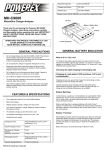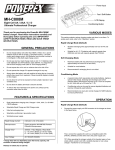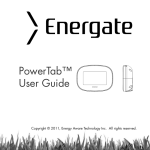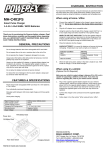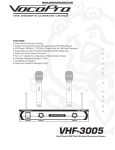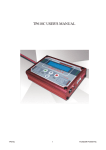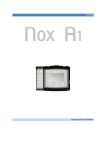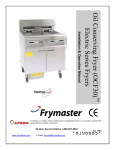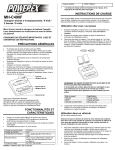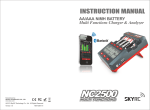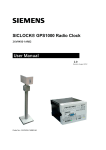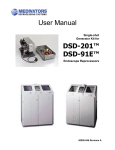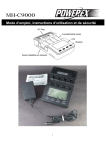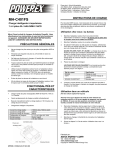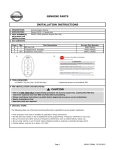Download Maha Powerex C9000 Manual
Transcript
Capacity Storage Memory: Supported Capacity*: 12 (Cycle mode only) 100 to 20,000mAh Charger Input Power: 12V 2.0A Adapter Input: 100-240V 50/60Hz * Always ensure that the batteries can accept the programmed rates. MH-C9000 WizardOne Charger-Analyzer Thank you for purchasing the Powerex MH-C9000 Charger-Analyzer. Read these instructions carefully and thoroughly before operating this unit. IMPORTANT SAFETY INSTRUCTIONS. READ AND SAVE THESE INSTRUCTIONS. OPERATING THIS PRODUCT INCORRECTLY CAN CAUSE DAMAGE TO THE BATTERIES. READ MANUAL COMPLETELY BEFORE USE. GENERAL PRECAUTIONS · Do not charge battery cells other than NiMH or NiCD. Please check with the battery manufacturer to ensure it can accept the programmed charging and discharging rates. Do not expose the unit to rain or moisture due to the risk of fire. · Do not operate the charger if it appears damaged in any way. · Always place the battery cells with positive tip facing the top. Incorrect polarity may cause fire or explosion. Observe polarity diagrams located on the charger. · Do not allow the unit to be exposed to direct sunlight. Operate in a well-ventilated area. Do not place unit on the carpet. · Do not allow the battery terminals to become shorted. · To reduce the risk of damage to the power cord, always pull by connector rather than the cord. · Use only the supplied adapter or optional regional and car adapter offered by Maha Energy. Using third party accessories voids the product warranty. GENERAL BATTERY EDUCATION What is 0.1C, 0.2C, etc? “C” stands for the battery capacity and the number preceeding it is the fraction of the battery capacity. For example, 0.1C means 0.1 times the capacity for the battery. For a 2700mAh battery, 0.1C would be 0.1 times 2700mAh which equals 270mA. Choosing the right charging & discharging rate Charging at a rate below 0.3C and above 1.0C is not recommended. Charging too slow may prevent the charger from terminating correctly. Charging too fast may damage the battery. Typically speaking, slower charging rate will yield better battery performance but requires longer time. Faster charging rate may not charge as fully and battery temperature can be higher. As for the discharging rate, do not exceed 1.0C. FEATURES & SPECIFICATIONS · Four independent slots for AA or AAA NiMH batteries. · Backlit LCD display. · Digitally displays capacity, voltage, time and current. · Five modes of operation: Charge, Refresh & Analyze, Break-In, Discharge and Cycle. · 19 selectable charging current from 0.2A to 2.0A. · 10 selectable discharging current from 0.1A to 1.0A. · Worldwide power supply. Battery Matching In most devices, usually two or more batteries are used together. When batteries are used in a series, the performance is limited by the worst one. In other words, one poorly performing battery can significantly reduce the device runtime. Battery matching refers to grouping batteries with similar “actual” capacity. To perform this, use the Refresh & Analyze mode to determine the battery capacity. Group batteries with capacity within about +/- 5% of the rated capacity. Battery “Forming” Charging Current: Programmable from 0.2A to 2.0A in increments of 0.1A New batteries and those stored for extended period become chemically deactivated. Battery forming is a charge-discharge-charge cycle which forces a full charge into the battery at a very slow rate. This process activates the battery. In certain cases, it needs to be repeated two or three times. Topoff Charging Current: 100mA Battery forming can be performed using the Break-In mode. Maintenance Charging Current: Discharge Termination: 10mA Discharging Current: Programmable from 0.1A to 1.0A in increments of 0.1A Voltage 0.90V PRINTED IN TAIWAN A03-3713420-511 Battery Rescue Steps MODES OF OPERATION This section describes the various modes and when to use them. To enable each mode, refer to the “Operation” section. Charge Mode · Recharges the battery at the selected rate. · Useful when battery needs to be recharged without determining the capacity of the battery. It should be used on batteries known to be in good condition and have been in continuous use. · Requires the least amount of time. For batteries that do not perform favorably after using the mode recommended above, the following sequence can be applied. 1. Refresh & Analyze for one to three times. 2. If capacity is still low, use Break-In mode. 3. If the step 1 to step 2 shows some capacity improvement (> 10%), repeat Break-In mode for one to three times. If no significant improvement is observed, battery probably at end of useful life. OPERATIONS 1. Refresh & Analyze Mode Connect the power adapter DC connector to the charger. Plug the power adapter into a compatible outlet. · First recharges the battery, rest for two hours, discharges, rest, then recharges again. Charging and discharging rates are programmable. · Reports the discharge capacity at the end of the cycle. · Useful when the battery capacity needs to be determined. Also useful for battery with degraded performance. 2. Raise the lift rod located on the backside of the charger. Recommended once every ten cycles for NiMH batteries. 3. Insert AA or AAA battery. · TIP: When operating the charger outside of its intended region of use, simply use a plug-changer (Maha part number MHS-TC400 worldwide plug-changer kit). Transformer is not necessary. Insert the negative end first, as shown below. Break-In Mode (IEC capacity analysis) · Applies a 16-hour 0.1C charge (0.1 times the capacity of the battery), rest of one hour, followed by a 0.2C discharge, rest again, and finally a 16-hour 0.1C recharge again. · Recommended for brand-new batteries. This process is also known as “Forming Charge.” Also recommended with batteries that cannot be rescued by the Refresh & Analyze mode. · Recommended once every 30 cycles for NiMH batteries. Inserting AA / AAA batteries · Requires 39 to 45 hours to complete. · The process follows the IEC standard for determining battery capacity. TIP: If charging two batteries, inserting them in the first and fourth slot offers better cooling and lowers battery temperature. NOTE: It is normal for the batteries to become hot during charging and discharging. It is also normal for a faint noise to emanate from the charger during operation. Discharge Mode 4. · Discharges the battery at the selected rate. · Useful for analyzing the amount of charge stored in the battery. Battery not recharged at the end of the cycle. When a new battery is detected, the LCD will display an arrow below the bank number and prompt for the mode by flashing “MODE”. Cycle Mode · Performs a charge-discharge cycle for a programmable number of times. Charging and discharging rates are also selectable. At the end of the cycle, a final recharge is applied. · Suitable for cycling the batteries multiple times. Use the UP and DOWN arrow keys to choose the desired mode. Press ENTER to make the selection. If no key is pressed within ten seconds, the charger will proceed to the default mode which is charging with 1000mA rate. The following table summarized the recommended mode for typical battery conditions: Battery Condition Mode Brand-new batteries Break-In NiMH batteries that have been used frequently (at least once every two weeks) Charge Batteries in storage for more than two weeks but less than 3 month Refresh & Analyze Batteries in storage for more than 3 month Break-In If more than one battery is inserted at a time (without key press), the charger will prompt for programming in the order in which the batteries were inserted. 5. PRINTED IN TAIWAN A03-3713420-511 If CHARGE mode is selected: The charger will prompt for the charging rate by flashing “SET CHG RATE.” Use the UP and DOWN key to select the desired current. Press ENTER to make the selection. Refer to the “General Battery Education” section on choosing an appropriate rate. If REFRESH & ANALYZE mode is selected: The charger will prompt for the charging rate by flashing “SET CHG RATE.” Use the UP and DOWN key to choose the desired current. Press ENTER to make the selection. Then the screen will prompt from the discharging rate by flashing “SET DISCHG RATE.” Follow the same procedure as above. 6. To ensure safety, the charger performs a battery health “impedance check” at the beginning of the program. If the battery fails this test, “HIGH” would be displayed and program will be terminated. If BREAK-IN mode is selected: The charger will prompt for the battery capacity in order to calculate the charging and discharging rate automatically. “SET BATTERY CAPACITY” icon will flash. Use the UP and DOWN key to choose the desired current. Press ENTER to make the selection. Typically alkaline and extremely aged battery will fail this test. For a rechargeable battery, it is recommended for the battery to be discarded. NOTE: This test is not performed for the discharge mode. If this detection is believed to be incorrect, a discharge can be performed first. 7. If DISCHARGE mode is selected: The charger will prompt for the discharging rate by flashing “SET DISCHG RATE.” Use the UP and DOWN key to choose the desired current. Press ENTER to make the selection. When the programs are in-progress, the charger will display the battery status for each occupied slot consecutively. The screen will first show an arrow below the active bank and display the information. The next slot(s) occupied follows. Press the SLOT button at anytime will jump to the next occupied slot. Press this button multiple times if necessary to go to the desired slot. The following information is displayed on the screen: Current: This is the number followed by the unit “MA.” This is the approximate charging or discharging current. Note that this number will go up and down due to the pulse charging. If CYCLE mode is selected: The charger will prompt for the charging rate and discharging rate similar to the other modes. In addition, it will also prompt for the number of cycles to be performed by flashing “SET CYCLES.” Use the UP and DOWN keys to choose the desired cycles. Press ENTER to make the selection. Capacity: This is the number followed by the unit “MAH.” This is the accumulated charging or discharging capacity. If it is charging capacity, “CHARGE” in black box will be shown. If it is discharging capacity, “DISCHG” in black box will be shown. PRINTED IN TAIWAN A03-3713420-511 Note the charging capacity is usually higher than the actual capacity of the battery owing to some energy lost as heat. Charging capacity cannot be used to judge the performance the battery. Instead, it can only be used to determine the progress of the charger. It is normal for this number to exceed the actual capacity by as much as 2030%. Q: I see that the charging capacity is much higher than the capacity I programmed. Why doesn’t the charger terminate correctly? A: The charger terminates by voltage and by temperature simultaneously. For certain older (and low quality) batteries, they do not produce the proper end-of-charge signal (a small voltage drop at the conclusion of the charge) needed for the charger to stop. At the same time, the battery temperature failed to reach the termination limit as the charging rate was probably too low. To address this issue, you should attempt to perform a BREAK-IN mode on the batteries first. You should also use a higher charging rate. 9. When the program for a slot is completed, DONE will displayed to the right of the bank number. With the exception of DISCHARGE mode, topoff charge and trickle charge (continuous) will be applied. For CHARGE mode, the total charged capacity will be displayed. For REFRESH & ANALYZE, BREAK-IN, DISCHARGE mode, the total discharge capacity will be displayed. “AVAILABLE CAPACITY” icon will also be shown. For CYCLE mode, the discharge capacity of the final cycle is displayed. “CYCLE HISTORY” icon will also be shown. Use the UP and DOWN key to access discharge capacity for all the cycles performed. The capacity information will be stored as long as the battery is inserted in the charger. It will be lost upon removal of the battery. Q: Using the BREAK-IN mode, I am seeing a charging capacity much higher than the capacity I programmed. A: When using the BREAK-IN mode, the charger puts in 1.6 times the capacity of the battery (entered at the start of the charge). This does not cause any harm to the battery as the charging rate is very low (only 10% of the battery capacity). The increased total charging capacity compensates for energy lost as heat. Time: This is the number followed by the unit “MIN.” This is the time elapsed for the particular routine such as charging, discharging or rest in the program. Voltage: This is the number followed by the unit “VOLT.” It represents the battery voltage. If you compare this with a voltmeter while charging, the values will not match as a voltmeter is unable to measure the battery voltage during charging or discharging. Warning! Batteries should be disposed of seperately from the municipal waste stream via designated collection facilities appointed by the government or the local authorities. For more detailed information about the disposal of batteries, please contact your city office, waste disposal service or the shop where you purchased the product. At any given time during the program, the charger will either be charging, discharging or resting. The LCD displays the action in black boxes containing CHARGE, DISCHG, or REST. Manufactured By: MAHA ENERGY CORP. 8. If CYCLE mode is selected, it is also possible to review the battery capacity of the completed cycle after the first cycle finishes. Press the UP or DOWN key while the active slot is in the cycle mode will display the discharge capacity for that cycle. The LCD will also display “CYCLE HISTORY.” PRINTED IN TAIWAN A03-3713420-511 1647 Yeager Ave. La Verne, CA 91750 USA Tel: 1-800-376-9992, 1-909-392-1568 http://www.mahapowerex.eu/ Copyrighted ® 1993-2007 Maha Energy Corp.




